.gif)
Gorch Fock (1933)
Encyclopedia
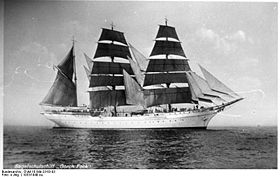
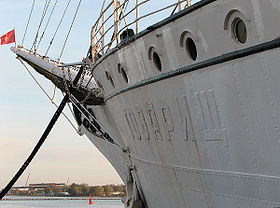
Germany
Germany , officially the Federal Republic of Germany , is a federal parliamentary republic in Europe. The country consists of 16 states while the capital and largest city is Berlin. Germany covers an area of 357,021 km2 and has a largely temperate seasonal climate...
three-mast barque
Barque
A barque, barc, or bark is a type of sailing vessel with three or more masts.- History of the term :The word barque appears to have come from the Greek word baris, a term for an Egyptian boat. This entered Latin as barca, which gave rise to the Italian barca, Spanish barco, and the French barge and...
, the first of a series built as school ship
School ship
A training ship is a ship used to train students as sailors. The term is especially used for ships employed by navies to train future officers. Essentially there are two types: those used for training at sea and old hulks used to house classrooms....
s for the German Reichsmarine
Reichsmarine
The Reichsmarine was the name of the German Navy during the Weimar Republic and first two years of Nazi Germany. It was the naval branch of the Reichswehr, existing from 1918 to 1935...
in 1933. She was taken as war reparations by the USSR
Soviet Union
The Soviet Union , officially the Union of Soviet Socialist Republics , was a constitutionally socialist state that existed in Eurasia between 1922 and 1991....
after World War II
World War II
World War II, or the Second World War , was a global conflict lasting from 1939 to 1945, involving most of the world's nations—including all of the great powers—eventually forming two opposing military alliances: the Allies and the Axis...
and renamed Tovarishch. After a short period under the Ukrainian
Ukraine
Ukraine is a country in Eastern Europe. It has an area of 603,628 km², making it the second largest contiguous country on the European continent, after Russia...
flag in the 1990s and a prolonged stay in British ports due to lack of funds for necessary repairs, the ship was acquired by sponsors and sailed to her original home port of Stralsund
Stralsund
- Main sights :* The Brick Gothic historic centre is a UNESCO World Heritage Site.* The heart of the old town is the Old Market Square , with the Gothic Town Hall . Behind the town hall stands the imposing Nikolaikirche , built in 1270-1360...
, where her original name of Gorch Fock was restored on November 29, 2003. She is a museum ship
Museum ship
A museum ship, or sometimes memorial ship, is a ship that has been preserved and converted into a museum open to the public, for educational or memorial purposes...
, and extensive repairs were carried out in 2008
The Federal German government built a replacement training ship, the Gorch Fock (1958)
Gorch Fock (1958)
The Gorch Fock is a tall ship of the German Navy . She is the second ship of that name and a sister ship of the Gorch Fock built in 1933. Both ships are named in honor of the German writer Johann Kinau who wrote under the pseudonym "Gorch Fock" and died in the battle of Jutland/Skagerrak in 1916...
, which is still in service.
History and details
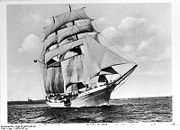
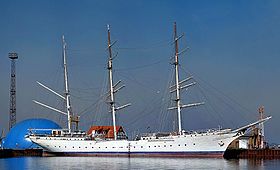
Segelschulschiff Niobe
The Segelschulschiff Niobe was a tall ship used by the German Navy to train cadets and aspiring NCOs. She sank during a sudden squall on 26 July 1932...
, a four-masted barque, capsized on July 26, 1932 in the Baltic Sea
Baltic Sea
The Baltic Sea is a brackish mediterranean sea located in Northern Europe, from 53°N to 66°N latitude and from 20°E to 26°E longitude. It is bounded by the Scandinavian Peninsula, the mainland of Europe, and the Danish islands. It drains into the Kattegat by way of the Øresund, the Great Belt and...
near Fehmarn
Fehmarn
Fehmarn is an island and - since 2003 - a town on this island in the Baltic Sea, off the eastern coast of Schleswig-Holstein, Germany, and ca. 18 kilometers south of the Danish island of Lolland...
due to a sudden squall, killing 69. The loss prompted the German Navy to order a new training vessel built. The contract went to the shipyard of Blohm & Voss in Hamburg
Hamburg
-History:The first historic name for the city was, according to Claudius Ptolemy's reports, Treva.But the city takes its modern name, Hamburg, from the first permanent building on the site, a castle whose construction was ordered by the Emperor Charlemagne in AD 808...
, where construction began on December 2, 1932. She was completed in only 100 days. On May 3, 1933 the ship was launched and baptized Gorch Fock in honor of German writer Johann Kinau who wrote under the pseudonym "Gorch Fock". Kinau had died in the 1916 Battle of Jutland
Battle of Jutland
The Battle of Jutland was a naval battle between the British Royal Navy's Grand Fleet and the Imperial German Navy's High Seas Fleet during the First World War. The battle was fought on 31 May and 1 June 1916 in the North Sea near Jutland, Denmark. It was the largest naval battle and the only...
aboard the cruiser SMS Wiesbaden
SMS Wiesbaden
SMS Wiesbaden was the lead ship of the Wiesbaden-class of light cruisers of the German Imperial Navy in World War I, the other being the Frankfurt-Specifications:...
.
Commissioned by the German Navy on June 26, 1933, the "Gorch Fock" is a three masted barque
Barque
A barque, barc, or bark is a type of sailing vessel with three or more masts.- History of the term :The word barque appears to have come from the Greek word baris, a term for an Egyptian boat. This entered Latin as barca, which gave rise to the Italian barca, Spanish barco, and the French barge and...
. She has square sails on the fore and main masts, and is gaff rigged
Rigging
Rigging is the apparatus through which the force of the wind is used to propel sailboats and sailing ships forward. This includes masts, yards, sails, and cordage.-Terms and classifications:...
on the mizzen. The hull steel and has a sparred length of 82.1 m (269 ft), a width of 12 m (39 ft) and a draught of 5.2 m (17 ft). She has a displacement at full load of 1510 ton
Tonnage
Tonnage is a measure of the size or cargo carrying capacity of a ship. The term derives from the taxation paid on tuns or casks of wine, and was later used in reference to the weight of a ship's cargo; however, in modern maritime usage, "tonnage" specifically refers to a calculation of the volume...
s. Her main mast stands 41.3 m (135 ft) high above deck and she carries 23 sails totalling 1753 m² (2,097 sq yd). She is equipped with an auxiliary engine of 410 kW (550 hp
Horsepower
Horsepower is the name of several units of measurement of power. The most common definitions equal between 735.5 and 750 watts.Horsepower was originally defined to compare the output of steam engines with the power of draft horses in continuous operation. The unit was widely adopted to measure the...
).
The training ship was designed to be robust and safe against capsizing. More than 300 tons of steel ballast in the keel give her a righting moment large enough to bring her back in the upright position even when she heels over to nearly a 90°.
The Gorch Fock served as a training vessel for the German Reichsmarine prior to World War II
World War II
World War II, or the Second World War , was a global conflict lasting from 1939 to 1945, involving most of the world's nations—including all of the great powers—eventually forming two opposing military alliances: the Allies and the Axis...
. During the war, she was a stationary office ship in Stralsund, until she was officially reactivated on April 19, 1944. On 1 May 1945, the crew scuttled her in shallow waters off Rügen
Rügen
Rügen is Germany's largest island. Located in the Baltic Sea, it is part of the Vorpommern-Rügen district of Mecklenburg-Vorpommern.- Geography :Rügen is located off the north-eastern coast of Germany in the Baltic Sea...
in an attempt to avoid her capture by the Soviets, who already had fired at her for 45 minutes with tanks.
The Soviets ordered Stralsund-based company "B. Staude Schiffsbergung" to raise and salvage her, which after some difficulties was done in 1947 at a cost of 800,000 Reichsmark. She was under restoration between 1948 and 1950. She was then named Tovarishch ("Comrade" in Russian
Russian language
Russian is a Slavic language used primarily in Russia, Belarus, Uzbekistan, Kazakhstan, Tajikistan and Kyrgyzstan. It is an unofficial but widely spoken language in Ukraine, Moldova, Latvia, Turkmenistan and Estonia and, to a lesser extent, the other countries that were once constituent republics...
) in 1951 and put into service as a training vessel. Her new home port was Odessa
Odessa
Odessa or Odesa is the administrative center of the Odessa Oblast located in southern Ukraine. The city is a major seaport located on the northwest shore of the Black Sea and the fourth largest city in Ukraine with a population of 1,029,000 .The predecessor of Odessa, a small Tatar settlement,...
. She participated in many Tall Ships' Races and cruised far and wide on the seven seas. She made a voyage around the world in 1957 and won the Operation Sail
Operation Sail
Operation Sail refers to a series of sailing events held to celebrate special occasions and features sailing vessels from around the world. Each event is coordinated by Operation Sail, Inc., a non-profit organization established in 1961 by President John F. Kennedy and must be approved by the...
race twice, in 1974 and 1976.
After the dissolution of the Soviet Union
Dissolution of the Soviet Union
The dissolution of the Soviet Union was the disintegration of the federal political structures and central government of the Union of Soviet Socialist Republics , resulting in the independence of all fifteen republics of the Soviet Union between March 11, 1990 and December 25, 1991...
in 1991, the Tovarishch sailed under the Ukrainian
Ukraine
Ukraine is a country in Eastern Europe. It has an area of 603,628 km², making it the second largest contiguous country on the European continent, after Russia...
flag (home port Kherson
Kherson
Kherson is a city in southern Ukraine. It is the administrative center of the Kherson Oblast , and is designated as its own separate raion within the oblast. Kherson is an important port on the Black Sea and Dnieper River, and the home of a major ship-building industry...
) until 1993, when she was needed repairs and deactivated for lack of funds. In 1995, she sailed from Kherson to Newcastle-upon-Tyne, where private sponsors wanted to have her repaired. This failed because of the high costs, and in 1999, the ship was transported to Wilhelmshaven
Wilhelmshaven
Wilhelmshaven is a coastal town in Lower Saxony, Germany. It is situated on the western side of the Jade Bight, a bay of the North Sea.-History:...
, where she stayed in dock for four years until finally transferred to Stralsund
Stralsund
- Main sights :* The Brick Gothic historic centre is a UNESCO World Heritage Site.* The heart of the old town is the Old Market Square , with the Gothic Town Hall . Behind the town hall stands the imposing Nikolaikirche , built in 1270-1360...
in 2003. On November 29, 2003 the ship was re-christened Gorch Fock.
As of 2011 the ship is in poor but stable condition. There is about six million dollars worth of restoration work required to bring this ship back to sailing condition. The museum had a dismal tourist season resulting in a fifty thousand dollar loss in revenue from previous years. This has forced a layoff of five workers. for further information and to help save this ship visit the webstite http://www.gorchfock1.de/front_content.php?idcat=29
Sister ships
The design of the Gorch Fock proved highly successful. She was the first of a series of five ships built by Blohm & Voss, and a number of South AmericaSouth America
South America is a continent situated in the Western Hemisphere, mostly in the Southern Hemisphere, with a relatively small portion in the Northern Hemisphere. The continent is also considered a subcontinent of the Americas. It is bordered on the west by the Pacific Ocean and on the north and east...
n school ships are also based on the same design. Of the three original sister ships, only the Mircea
Mircea (ship)
The Mircea is a three masted barque, built in 1938 in Hamburg by the Blohm & Voss shipyard as a training vessel for the Romanian Navy. Her design is based on the successful plans of the Gorch Fock; the last of a series of four sister ships. The ship is named after the Wallachian Prince Mircea the...
is an exact replica of the Gorch Fock. The Horst Wessel and the Albert Leo Schlageter
Albert Leo Schlageter (sailing ship)
The NRP Sagres is a tall ship and school ship of the Portuguese Navy since 1961. It is the third ship with this name in the Portuguese Navy, so she is also known as Sagres III....
are 7 meters longer, and all three have slightly more powerful auxiliary engines.
USCGC Eagle (ex Horst Wessel)
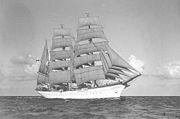
Reichsmarine
The Reichsmarine was the name of the German Navy during the Weimar Republic and first two years of Nazi Germany. It was the naval branch of the Reichswehr, existing from 1918 to 1935...
needed more school ships. Her home port was Kiel
Kiel
Kiel is the capital and most populous city in the northern German state of Schleswig-Holstein, with a population of 238,049 .Kiel is approximately north of Hamburg. Due to its geographic location in the north of Germany, the southeast of the Jutland peninsula, and the southwestern shore of the...
. At the end of World War II
World War II
World War II, or the Second World War , was a global conflict lasting from 1939 to 1945, involving most of the world's nations—including all of the great powers—eventually forming two opposing military alliances: the Allies and the Axis...
, she was assigned to the U.S.
United States
The United States of America is a federal constitutional republic comprising fifty states and a federal district...
After some repairs in Wilhelmshaven
Wilhelmshaven
Wilhelmshaven is a coastal town in Lower Saxony, Germany. It is situated on the western side of the Jade Bight, a bay of the North Sea.-History:...
and Bremerhaven
Bremerhaven
Bremerhaven is a city at the seaport of the free city-state of Bremen, a state of the Federal Republic of Germany. It forms an enclave in the state of Lower Saxony and is located at the mouth of the River Weser on its eastern bank, opposite the town of Nordenham...
, she was sailed by her German crew including the Captain together with American sailors to her new home port of New London, Connecticut
New London, Connecticut
New London is a seaport city and a port of entry on the northeast coast of the United States.It is located at the mouth of the Thames River in New London County, southeastern Connecticut....
. Since then, she sails under the name Eagle
USCGC Eagle (WIX-327)
The is a barque used as a training cutter for future officers of the United States Coast Guard. She is one of only two active commissioned sailing vessels in American military service, the other being the USS Constitution....
for the United States Coast Guard
United States Coast Guard
The United States Coast Guard is a branch of the United States Armed Forces and one of the seven U.S. uniformed services. The Coast Guard is a maritime, military, multi-mission service unique among the military branches for having a maritime law enforcement mission and a federal regulatory agency...
.
Sagres III (ex Albert Leo Schlageter)
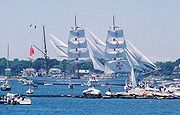
United States
The United States of America is a federal constitutional republic comprising fifty states and a federal district...
after World War II
World War II
World War II, or the Second World War , was a global conflict lasting from 1939 to 1945, involving most of the world's nations—including all of the great powers—eventually forming two opposing military alliances: the Allies and the Axis...
, and then sold to Brazil
Brazil
Brazil , officially the Federative Republic of Brazil , is the largest country in South America. It is the world's fifth largest country, both by geographical area and by population with over 192 million people...
, where she sailed as a school ship under the name Guanabara. In 1961, the Portuguese Navy
Portuguese Navy
The Portuguese Navy is the naval branch of the Portuguese Armed Forces which, in cooperation and integrated with the other branches of the Portuguese military, is charged with the military defence of Portugal....
bought her to replace the old school ship Sagres II (which was later transferred to Hamburg
Hamburg
-History:The first historic name for the city was, according to Claudius Ptolemy's reports, Treva.But the city takes its modern name, Hamburg, from the first permanent building on the site, a castle whose construction was ordered by the Emperor Charlemagne in AD 808...
, where she is a museum ship under her original name Rickmer Rickmers
Rickmer Rickmers
Rickmer Rickmers is a sailing ship permanently moored as a museum ship in Hamburg, near the Cap San Diego.Rickmer Clasen Rickmers, was a Bremerhaven shipbuilder and Willi Rickmer Rickmers, led a Soviet-German expedition to the Pamirs in 1928.The Rickmer Rickmers was built in 1896 by the Rickmers...
). The Portuguese named her accordingly Sagres III. She still sails as of 2011, having completed a circumnavigation on the 24th of December 2010.
Mircea
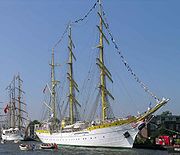
Mircea (ship)
The Mircea is a three masted barque, built in 1938 in Hamburg by the Blohm & Voss shipyard as a training vessel for the Romanian Navy. Her design is based on the successful plans of the Gorch Fock; the last of a series of four sister ships. The ship is named after the Wallachian Prince Mircea the...
was built by Blohm & Voss for the Romanian Navy
Romanian Naval Forces
The Romanian Navy is the navy branch of the Romanian Armed Forces; it operates in the Black Sea and on the Danube.-History:-Development of the Romanian Navy:The Romanian Navy has been founded in 1860 as a river flotilla on the Danube...
. She was launched in 1938 and has always sailed under the Romanian flag
Flag of Romania
The national flag of Romania is a tricolour with vertical stripes: beginning from the flagpole, blue, yellow and red. It has a width-length ratio of 2:3....
(except for a short period after WWII, when she was confiscated by the Soviet Union
Soviet Union
The Soviet Union , officially the Union of Soviet Socialist Republics , was a constitutionally socialist state that existed in Eurasia between 1922 and 1991....
). She is the only one of the sister ships that is truly identical to the Gorch Fock. She was overhauled at the Blohm & Voss shipyards in Hamburg in 1966, and she still sails .
Herbert Norkus
Named after the Hitler YouthHitler Youth
The Hitler Youth was a paramilitary organization of the Nazi Party. It existed from 1922 to 1945. The HJ was the second oldest paramilitary Nazi group, founded one year after its adult counterpart, the Sturmabteilung...
martyr Herbert Norkus
Herbert Norkus
Herbert Norkus was a Hitler Youth member who was killed by German Communists. He became a role model and martyr for the Hitler Youth and was widely used in Nazi propaganda, most prominently as the subject of novel and movie Hitler Youth Quex.- Background :Born to a working class family in the...
, another ship of the Gorch Fock design—with the same dimensions as the Horst Wessel—was begun at the Blohm & Voss shipyard. However,the unfinished ship had to be launched prematurely on November 7, 1939 because the slipway had to be cleared to build submarine
Submarine
A submarine is a watercraft capable of independent operation below the surface of the water. It differs from a submersible, which has more limited underwater capability...
s. The hull stayed in the harbor of Hamburg
Hamburg
-History:The first historic name for the city was, according to Claudius Ptolemy's reports, Treva.But the city takes its modern name, Hamburg, from the first permanent building on the site, a castle whose construction was ordered by the Emperor Charlemagne in AD 808...
throughout World War II. It was damaged in a bomb raid in 1945, and instead of being sold to Brazil as had been considered, ended up being filled with gas grenades and sunk in the Skagerrak
Skagerrak
The Skagerrak is a strait running between Norway and the southwest coast of Sweden and the Jutland peninsula of Denmark, connecting the North Sea and the Kattegat sea area, which leads to the Baltic Sea.-Name:...
in 1947.
The yards, which had been prepared, but not yet mounted, and the tackle, which had not yet been rigged, were later used for the Gorch Fock built in 1958.
Gorch Fock

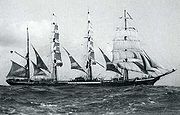
World War II
World War II, or the Second World War , was a global conflict lasting from 1939 to 1945, involving most of the world's nations—including all of the great powers—eventually forming two opposing military alliances: the Allies and the Axis...
, the West German Bundesmarine decided in 1957 to have a new training ship built following the plans for the Gorch Fock. The new ship was a modernized rebuild of the Segelschulschiff Horst Wessel. Coincidentally, her design had been influenced by another shipwreck: whereas the 1933 Gorch Fock was built in response to the Niobe
Segelschulschiff Niobe
The Segelschulschiff Niobe was a tall ship used by the German Navy to train cadets and aspiring NCOs. She sank during a sudden squall on 26 July 1932...
disaster, the plans of the SSS Gorch Fock were altered somewhat after the sinking of the Pamir
Pamir (ship)
Pamir was one of the famous Flying P-Liner sailing ships of the German shipping company F. Laeisz. She was the last commercial sailing ship to round Cape Horn, in 1949...
in 1957.
The modern-day SSS Gorch Fock
Gorch Fock (1958)
The Gorch Fock is a tall ship of the German Navy . She is the second ship of that name and a sister ship of the Gorch Fock built in 1933. Both ships are named in honor of the German writer Johann Kinau who wrote under the pseudonym "Gorch Fock" and died in the battle of Jutland/Skagerrak in 1916...
was launched on August 23, 1958 and commissioned on December 17 of that year.
Latin American ships
A number of similar ships have been built by the Astilleros Celaya S.A. shipyard in BilbaoBilbao
Bilbao ) is a Spanish municipality, capital of the province of Biscay, in the autonomous community of the Basque Country. With a population of 353,187 , it is the largest city of its autonomous community and the tenth largest in Spain...
for Latin America
Latin America
Latin America is a region of the Americas where Romance languages – particularly Spanish and Portuguese, and variably French – are primarily spoken. Latin America has an area of approximately 21,069,500 km² , almost 3.9% of the Earth's surface or 14.1% of its land surface area...
n Navies, possibly following the Blohm & Voss design. The hulls and rigging of these ships are very similar, the main differences are in the superstructure and they also have larger tanks for both diesel and water, and they are also longer. These ships are the Gloria
ARC Gloria
The ARC Gloria is a training ship and official flagship of the Colombian Navy."ARC" stands for "Armada Nacional de la República de Colombia."- History :...
(1967, Colombia
Colombia
Colombia, officially the Republic of Colombia , is a unitary constitutional republic comprising thirty-two departments. The country is located in northwestern South America, bordered to the east by Venezuela and Brazil; to the south by Ecuador and Peru; to the north by the Caribbean Sea; to the...
), the Guayas
Guayas (ship)
The Guayas is a sail training ship of the Ecuadoran Navy. Launched in 1976 it was named in jointly in honor of Chief Guayas, the Guayas river, and Guayas, the first steamship that was constructed in South America in 1841 and is displayed on the Ecuadorian coat of arms...
(1976, Ecuador
Ecuador
Ecuador , officially the Republic of Ecuador is a representative democratic republic in South America, bordered by Colombia on the north, Peru on the east and south, and by the Pacific Ocean to the west. It is one of only two countries in South America, along with Chile, that do not have a border...
), the Simón Bolívar
Simón Bolívar (barque)
Simón Bolívar is a training vessel for the Venezuelan Navy. She sails from the home port of La Guaira and is a frequent participant in tall ship events. She is named after Simón Bolívar, the liberator of Bolivia, Colombia, Peru, Ecuador, Panama and Venezuela.-Design:Simón Bolívar was built in the...
(1979, Venezuela
Venezuela
Venezuela , officially called the Bolivarian Republic of Venezuela , is a tropical country on the northern coast of South America. It borders Colombia to the west, Guyana to the east, and Brazil to the south...
), and the Cuauhtémoc (1982, Mexico
Mexico
The United Mexican States , commonly known as Mexico , is a federal constitutional republic in North America. It is bordered on the north by the United States; on the south and west by the Pacific Ocean; on the southeast by Guatemala, Belize, and the Caribbean Sea; and on the east by the Gulf of...
).
External links
- The correct homepage of "Gorch Fock 1"
- ESYS page on the whole family of ships (in GermanGerman languageGerman is a West Germanic language, related to and classified alongside English and Dutch. With an estimated 90 – 98 million native speakers, German is one of the world's major languages and is the most widely-spoken first language in the European Union....
). - ESYS page with links to the five original ships (in German).
- JanMaat—another German site on the Gorch Fock (ex Tovarishch).

